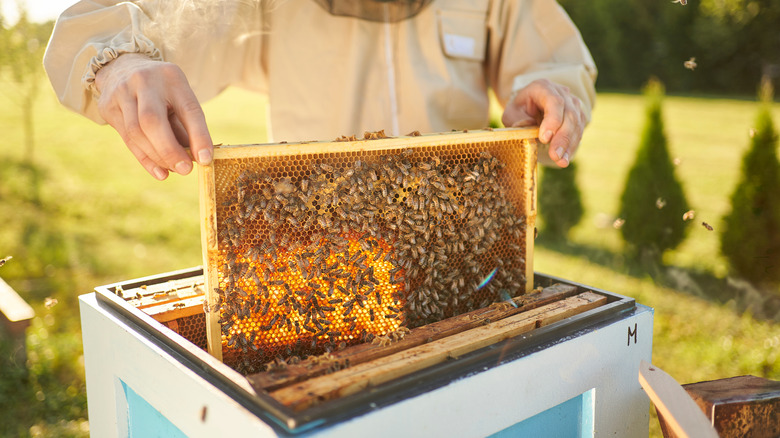Are Honeycombs Safe To Eat (And What Do They Taste Like)?
When you think of honey, you may picture little bear-shaped plastic bottles filled with dark golden liquid, ready to be squeezed into a hot cup of tea or drizzled onto a peanut butter sandwich. But before you toss that plastic honey bear into your grocery cart, you might want to consider some alternatives.
The processed honey available on most grocery store shelves has been heated and stripped of some of its health benefits. Raw honey, on the other hand, is pure and unfiltered, retaining beneficial vitamins and minerals. And it's every bit as sweet and scrumptious as its processed counterpart (maybe even more so).
The good news doesn't stop there. When bees create honey in their hives, the beeswax forms a waxy tray filled with tiny, hexagonal nooks and crannies, called honeycomb. Honeycomb has a delicate, wafer-like texture, is completely safe to eat, and comes packed with natural health benefits.
Honeycomb has a long list of benefits
If you're put off by the thought of eating honey straight from the hive, don't be — Winnie the Pooh knew what he was doing. Honeycomb and raw honey contain antimicrobial properties due to their high Ph levels & certain enzymes created by honeybees. This makes it nearly impossible for bacteria to survive in raw honey, so long as it's stored properly. (Just ask the archaeologists who discovered thousand-year old honey pots in Egyptian tombs, preserved so well that they're still edible.) If you don't have an Egyptian tomb handy, don't worry; the pantry (or any cool, dry place) will do just fine.
Honey and honeycomb are also packed with antioxidants and amino acids and make a great moisturizer or a soothing cough suppressant when added to tea — or just eaten by the spoonful. Beeswax may even help to lower "bad" LDL cholesterol, and boost immunity. Honeycomb and raw honey may also be a good sugar substitute for those with diabetes: while it does contain fructose and glucose, its sweetness is concentrated, meaning a little honey can stand in for a lot of sugar.
There are a couple of cautions to consider, however. Healthline recommends that pregnant women, children under age 12, and those who are allergic to pollen, use caution when consuming honeycomb; it's best to start with small amounts.
Sweet ways to enjoy honeycomb
Honeycomb can be enjoyed in many different ways, but it goes especially well with cheese. The Asheville Bee Charmer, a shop and honey-tasting bar in Asheville, North Carolina, recommends pairing honeycomb with "hard, salty cheeses" like Pecorino or Manchego. Honeycomb also makes a visually stunning centerpiece on a charcuterie board, complementing any array of fruits and nuts. It's great on toast, or dipped in tea or hot chocolate. You can use raw honey in place of sugar in coffee or lemonade or add a bit of texture to yogurt with a piece of honeycomb. You can even chew the beeswax like bubble gum.
Don't worry if your honey or honeycomb crystallizes; that just means it's pure, raw honey. Putting the jar in a hot water bath is an easy, quick way to de-crystallize honey. You can also try adding two teaspoons of light corn syrup for every cup of honey to prevent it from happening in the first place.
However you choose to try it, honeycomb is a fun, healthy snack with plenty of sweet benefits.


